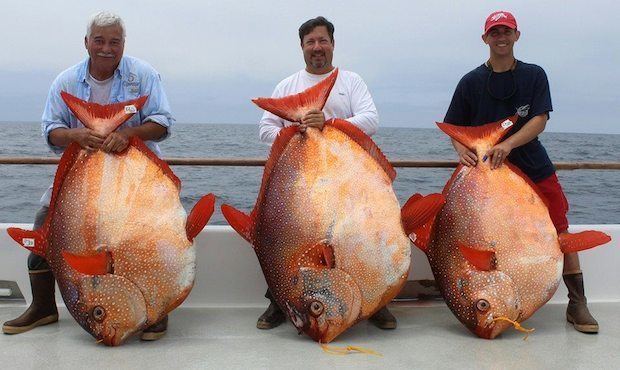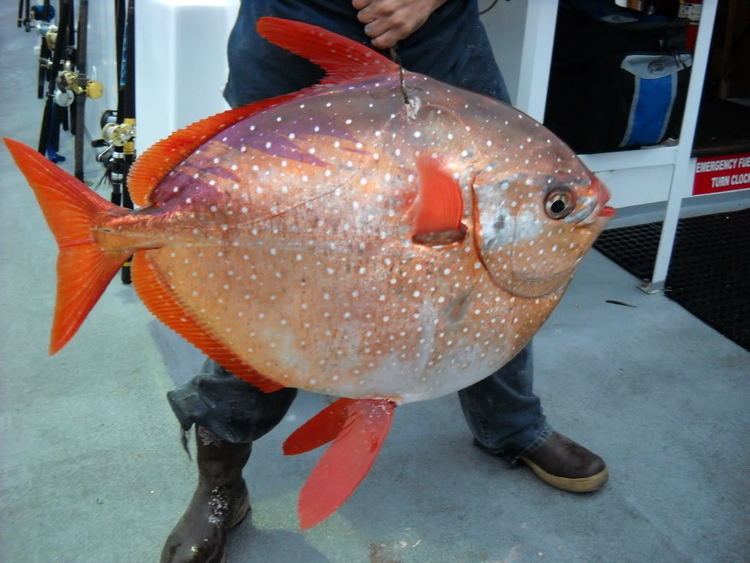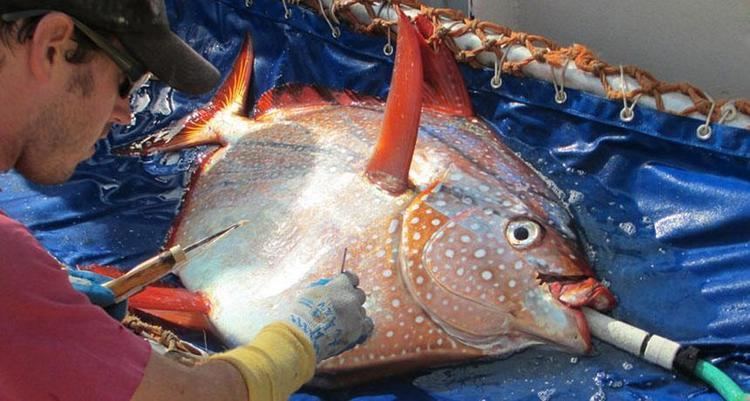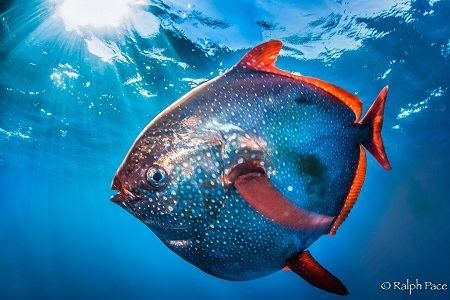Scientific name Lampris Phylum Chordata | Family Lampridae Higher classification Lampridae Rank Genus | |
 | ||
Similar Lampris guttatus, Lampriformes, Ocean sunfish, Lancetfish, Wahoo | ||
Opahs (also commonly known as moonfish, sunfish (not to be confused with Molidae), kingfish, redfin ocean pan, and Jerusalem haddock) are large, colorful, deep-bodied pelagic lampriform fishes comprising the small family Lampridae (also spelled Lamprididae). Only two living species occur in a single genus: Lampris (from the Greek lamprid-, "brilliant" or "clear"). One species is found in tropical to temperate waters of most oceans, while the other is limited to a circumglobal distribution in the Southern Ocean, with the 34°S as its northern limit. Two additional species, one in the genus Lampris and the other in the monotypic Megalampris, are only known from fossil remains. The extinct family, Turkmenidae, from the Paleogene of Central Asia, is closely related, though much smaller.
Contents
- Description
- First documented regionally endothermic fish with a warm heart
- Behavior
- Species and range
- Known fossil taxa
- References

Opah specimens are rarely caught by recreational anglers. They are prized trophies for deep-water anglers as their large size and attractive form lend themselves well to taxidermy. Opahs are frequently caught as bycatch in many longline tuna fisheries. Opah is becoming increasingly popular in seafood markets. It first became popular as a sushi and sashimi in the late 1980s and early 1990s. The meat is lightly flavored and lends itself well to a variety of preparations, principally sauté. Opah flesh has a light-pink to orange color, but turns white when cooked. It is popular in Hawaii, especially in restaurants. An average of 35% of an opah's weight is consumable, with the remaining 65% being bone and thick skin.

The opah is the first fish discovered to have a warm heart, in May 2015. The opah can keep most of its body consistently at a temperature above the water temperature.

Description

Opahs are deeply keeled, compressed, discoid fish with conspicuous coloration: the body is a deep red-orange grading to rosy on the belly, with white spots covering the flanks. Both the median and paired fins are a bright vermilion. The large eyes stand out, as well, ringed with golden yellow. The body is covered in minute cycloid scales and its silvery, iridescent guanine coating is easily abraded.

Opahs closely resemble in shape the unrelated butterfish (family Stromateidae). Both have falcated (curved) pectoral fins and forked, emarginated(notched) caudal fins. Aside from being significantly larger than butterfish, opahs have enlarged, falcated pelvic fins with about 14 to 17 rays, which distinguish them from superficially similar carangids—positioned thoracically; adult butterfish lack pelvic fins. The pectorals of opahs are also inserted (more or less) horizontally rather than vertically. The anterior portion of an opah's single dorsal fin (with about 50–55 rays) is greatly elongated, also in a falcated profile similar to the pelvic fins. The anal fin (around 34 to 41 rays) is about as high and as long as the shorter portion of the dorsal fin, and both fins have corresponding grooves into which they can be depressed.
The snout is pointed and the mouth small, toothless, and terminal. The lateral line forms a high arch over the pectoral fins before sweeping down to the caudal peduncle. The larger species, Lampris guttatus, may reach a total length of 2 m (6.6 ft) and a weight of 270 kg (600 lb). The lesser-known Lampris immaculatus reaches a recorded total length of just 1.1 m (3.6 ft).
First documented regionally endothermic fish with a warm heart
The opah is the newest addition to the list of regionally endothermic fish (warm-blooded), with a rete mirabile in its gill tissue structure, first described in 2015 as exhibiting counter-current heat exchange in which the arteries, carrying warm blood, from the heart, warm the veins in the gills carrying cold blood. The gills are cooled by contact with cold water. The opah's pectoral muscles generate most of its body heat. The opah retains heat with insulating layers of fat, which insulates the heart from the gills, and the pectoral muscles from the surrounding water. The opah is not homeothermic like birds and mammals.
Behavior
Almost nothing is known of opah biology and ecology. They are presumed to live out their entire lives in the open ocean, at mesopelagic depths of 50 to 500 m, with possible forays into the bathypelagic zone. They are apparently solitary, but are known to school with tuna and other scombrids. The fish propel themselves by a lift-based labriform mode of swimming, that is, by flapping their pectoral fins. This, together with their forked caudal fins and depressible median fins, indicates they swim at constantly high speeds like tuna.
Lampris guttatus are able to maintain their eyes and brain at 2 °C warmer than their bodies, a phenomenon called cranial endothermy and one they share with sharks in the Lamnidae family, billfishes and some tunas. This may allow their eyes and brains to continue functioning during deep dives into water below 4 °C.
Squid and euphausiids (krill) make up the bulk of the opah diet; small fish are also taken. Pop-up archival transmitting tagging operations have indicated, aside from humans, large pelagic sharks, such as great white sharks and mako sharks, are primary predators of opah. The tetraphyllidean tapeworm Pelichnibothrium speciosum has been found in L. guttatus, which may be an intermediate or paratenic host. The planktonic opah larvae initially resemble those of certain ribbonfishes (Trachipteridae), but are distinguished by the former's lack of dorsal and pelvic fin ornamentation. The slender hatchlings later undergo a marked and rapid transformation from a slender to deep-bodied form; this transformation is complete by 10.6 mm standard length in L. guttatus. Opahs are believed to have a low population resilience.
